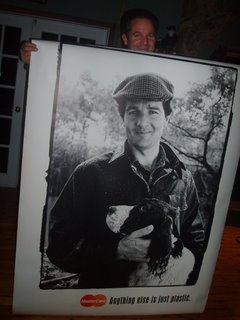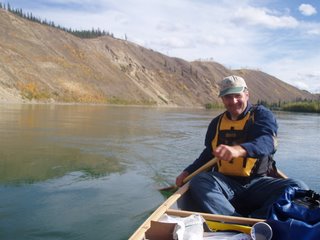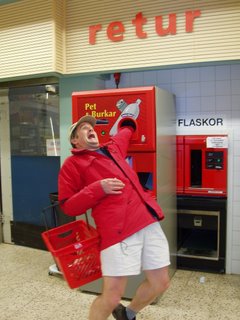Wednesday, January 06, 2010
the community is a system

When you first arrive on site here, it appears to be just another farm, with the first 4 visible buildings all conventional-looking and boxy. You then start to notice some of the cob buildings, with their soft curves and colourful bottles embedded into the earth-toned walls, the living rooftops, and some of the artwork created right into the structure. But to gain a full appreciation of the entire "system," a tour is needed, as I received a couple of weeks ago. Quite a bit of work has been done in the 10 or so years since the original founding members bought the property.

Currently there are a number of people working under an employment program, doing projects such as fencing, masonry (thanks to a local expert guiding the team) to build outdoor stairs, and terracing in the new garden area. They are carrying out many infrastructure projects that have piled up over the years. Many of them will stay for the busy summer months to assist with the hundreds of visitors to the site, to work in the gardens, and to help in the natural building projects, along with the educational programs.
The educational programs focus mainly on permaculture, and natural building. There are also interns, who are here to learn permaculture design by working the gardens. The garden includes to large greenhouses, and a few large outdoor plots.
The community has a healing "sanctuary," built as a demonstration of cob and straw bale construction, with a massage studio operated by one of the residents, a private residence, and a
 meeting room. It is a lovely space to spend time in; you can breathe in and smell the earthiness of it - no artificial materials here - and yet it is a very comfortable place, with heat radiating out of the floor.
meeting room. It is a lovely space to spend time in; you can breathe in and smell the earthiness of it - no artificial materials here - and yet it is a very comfortable place, with heat radiating out of the floor.The tour doesn't end there, however. There is a workshop, a "credit union" for humanure processing, a new timberframe cob and straw bale building going up, and many other aspects practicing the principle of "closed loop living".
Tuesday, January 05, 2010
community cooking

Tonight I'll be making a Shepherd's Pie with mince pork. The pork came from Thelma, a pig raised here last year. All the vegetables will be from the garden.
Chris and I have been using as many of the vegetables grown on site as we can. Since it's so warm here, and the greenhouse is still up, there's actually still quite a bit to harvest from the garden: kale, spinach, swiss chard, and all sorts of root veggies still in the garden like carrots, rutabagas, and parsnips. There's still lots of potatoes to eat, along with apples from the orchard.
The freezer is full of meat produced on site. In addition to Thelma, there is also lots of ducks and chickens in the freezer, a few turkeys, and every day the chickens produce 30 or so eggs. More than we can eat. It's really exciting to be eating so much food produced right here!
There are 4 sheep roaming around outside, but so far I think only their wool has been harvested; I'm not sure what the plans are for them.
The kitchen we cook in is make-shift and temporary. Plans are in the making to build communal space including a new kitchen.
I'm really quite enthused to offer some of my own design input for this future kitchen, which may or may not be used, some day. Think about it: there is so much to a sustainable communal kitchen compared to the kitchens normally used in this consumer, throw-away, high-food-miles society. A sustainable communal kitchen facilitates:
- all sorts of food preservation and processing technology, including food dryers, fermentation (eg, to produce krauts), yogurt and cheese making, pressure-cooker canning, flour milling, wood-fired oven, solar oven, Which leads to:
- local food procurement. Without proper food preservation and processing technology, the community needs to buy more of it's food already processed, which often means non-local. For example, much of the grain grown on the island is not milled. If we don't have a flour mill, we need to buy grain that is already milled, which is only available as non-local. If there is a flour mill set up and ready to use in the kitchen, we can more easily "buy local" because we can make our own flour from island-grown grain.
- lots of storage space to store food harvested on site. This includes lots of shelves for canned products, a root cellar, perhaps an ice-house for cool storage,
- ease of use. All of this infrastructure needs to be accessible, and largely built-in. For example, the food drying equipment needs to be built-in, not sitting disassembled in a box on a shelf, otherwise, the incentive to use it is greatly reduced
- zero-waste. In order to reach zero-waste, a sustainable kitchen needs to be set up carefully so that recycling and composting are really easy to accomplish. Recycling and composting stations need to be an integral part of the kitchen design, not an add-on, to maximize usage.
- green procurement. A sustainable kitchen supports green procurement by increasing the consumption of community and other local foods. This also assists in reaching zero-waste, as the reliance on non-local packaged food is greatly reduced, thereby reducing waste.
If anyone out there has some leads on plans for such a kitchen, please let me know!
What if?
Monday, January 04, 2010
Our intentional community bliss

Our new home! We've downsized quite a bit from my house in Whitehorse, but this 28-foot trailer it's keeping the rain off us, keeps us warm, and we can cook and read books quite comfortably. Besides, there is plenty of "common space" here in the community, and Fergus is quite happy in the "Tag 2" commonroom, where we eat communally. He even started walking there! He loves being around the other kids, and of course, the sheep.
This week, Chris and I are cooking for the 10 or so people here for the week. The usual cook, Marisa, has gone with her family to Toronto to visit a sick relative, and we agreed to fill in, as neither of us are working as yet and can afford the time.
For today's lunch I'm "going local" with a potato and fennel soup, Lemon-scented Quinoa Salad with our own scarlet runner beans thrown in, and tahini dressing. Chris is on dinner duty, with a leg pork roast (or "Thelma" as the resident six-year-old informed me one evening over dinner). We'll harvest veggies from the garden this afternoon to accompany Thelma.
Monday, February 18, 2008
winter 2008, thus far

One of the best things so far is having seen Pete Sims, our old classmate from Sweden. Here we are having some Pho together in Ottawa on Valentine's Day. Yay Pete!
Sunday, September 09, 2007
I'm living on Dog Lake

I'm living on Dog Lake about 25 minutes north of Kingston, Ontario. The area is mostly rural, and there's a new subdivision, full of sprawling brand-new houses at the beginning of our long driveway. These are owned by many "professional" people who mostly work at the university, or hospital (I belong to the local Ladies' Bookclub; I go mainly for the gourmet appies and wine!)
Down our little road, the neighborhood has a little more patina, with about 5 cottages 40 years old or more. Only 3 have year-round residents.
Labels: planting trees
Kate's big fish!

I went fishing with colleague, Chris, on Knowlton Lake. This was after we almost sunk his truck launching the boat. Predictably, with the boat launched, we decided to go fishing anyway! His truck didn't start again, after a nearby resident pulled it out, and didn't start for another 3 days. We got a ride back to town.
Nice sized lake trout - around 7 lbs?
Labels: August 2007, Kate's big fish, Knowlton Lake
Monday, November 27, 2006
Christmas in Ireland 2005
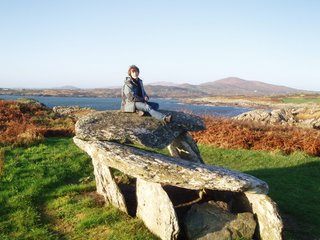 Chris and I took a break from Karlskrona, Sweden, the location of our year of schooling, to spend Christmas holidays in London and Ireland. We began at both of his brother's places, and continued for a week in Ireland, where we rented a car, starting the trip in Cork County.
Chris and I took a break from Karlskrona, Sweden, the location of our year of schooling, to spend Christmas holidays in London and Ireland. We began at both of his brother's places, and continued for a week in Ireland, where we rented a car, starting the trip in Cork County.Dec. 22 to 27
The 4 am train we took to
We got out of the city on the 24th to stay with
Dec. 27
Arrived in
Dec. 28
The road along the coast is very hilly, winding, and fast; these roads in Canada would have a speed limit of no more than 60 km/hour, but here it can be as high as 100. The towns along the coast are all much smaller than
We pulled into a hostel in
The self-serve kitchen of the hostel is a beautiful stone building, and we had dinner there and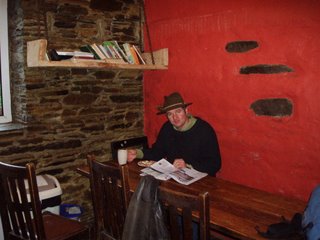 drank Beamish Draught, while
drank Beamish Draught, while
We also later checked out downtown
Dec. 29
Getting off to a late start, we ended up staying not too far from
We found the pub atmosphere in downtown Schull very friendly and relaxed; the Murpheys draught tasted particularly good there. Had a game of checkers and went back to the hostel we checked into for the night to cook a meal. Another couple staying here were off for some jazz and Irish music at Hackett’s pub, and we tried, we really tried to get there, but it was raining fiercely outside and I was falling asleep. Should have waited before having my beer so early in the evening. Hopefully come across some good music later in our trip!
Dec. 30
It stormed all night, and in the morning, the clouds parted again for a whole day of mostly sunshine, all the way around the 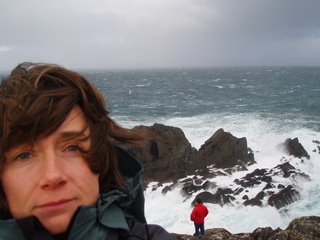 down to Dursey where the cable car connects the island off the very tip; we’re sure this is partly how the local kids get to school each day. We walked around the sheep-grazed field here overlooking the rocky coastline and watched the sea spray shooting into the air from the huge waves hitting the rocks; it was quite spectacular.
down to Dursey where the cable car connects the island off the very tip; we’re sure this is partly how the local kids get to school each day. We walked around the sheep-grazed field here overlooking the rocky coastline and watched the sea spray shooting into the air from the huge waves hitting the rocks; it was quite spectacular.
Later on, we had a bit of a hard time finding affordable accommodation. We had our heart set on the Buddhist hostel/retreat centre, but it was having a retreat this weekend, and was full. From what I saw it’s a prime place to stay since it’s in a remote area overlooking the rocky coastline, far from any community, and looks very cozy inside, with white adobe-looking buildings. We settled for a room in at the Ocean View Hotel in downtown Castletownbear. Here we met a young Canadian master’s degree graduate, Eric, who is getting some work experience in fisheries; he’s done some work around trans-genetics, and is currently working with a company here. The aquaculture industry is not very big in 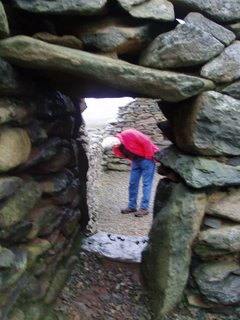
We spent some time in the evening at MacCarthy’s for a pint of Murpheys and
There isn’t any music in the pubs here in town! Very disappointing.
Anxious to get off to Kilarney for some hiking.
December 31
Luck of the Irish is the only way to describe how our day ended. Things started off well enough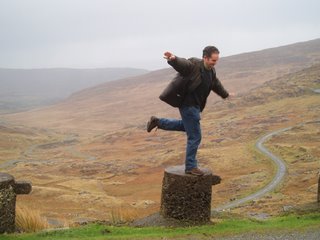 leaving Castletownbere, swearing we wouldn’t recommend the place we stayed in (the Ocean View Hotel) to anyone, and had an enjoyable drive through Healy Pass into Kerry County and all the way to Killarney. It was an hour away from darkness when we arrived since we had left the Ocean View a little late, lounging around in our room all morning, taking advantage of the extra-luxuriousness of having nothing to do but enjoy ourselves on holiday. That feeling lasted only until we got to Killarney and found ourselves on New Year’s Eve without reservations in a town with all accommodations booked solid, ditto for surrounding villages. Just as we were beginning to contemplate tenting on the rain-saturated ground at a nearby campsite (and dangerously close to finding out how graceful we can be under pressure)
leaving Castletownbere, swearing we wouldn’t recommend the place we stayed in (the Ocean View Hotel) to anyone, and had an enjoyable drive through Healy Pass into Kerry County and all the way to Killarney. It was an hour away from darkness when we arrived since we had left the Ocean View a little late, lounging around in our room all morning, taking advantage of the extra-luxuriousness of having nothing to do but enjoy ourselves on holiday. That feeling lasted only until we got to Killarney and found ourselves on New Year’s Eve without reservations in a town with all accommodations booked solid, ditto for surrounding villages. Just as we were beginning to contemplate tenting on the rain-saturated ground at a nearby campsite (and dangerously close to finding out how graceful we can be under pressure)
January 1
The Neptune Hostel is a great place to stay, but we’re close to a National Park and why not stay somewhere a little less down-town in the Killarney area? This is why, after
Prior to this day, I had imagined 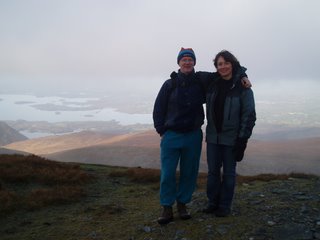 make the land soggy, slippery, and anywhere you go, foggy and hard to see where you’re going. Prior to this day, I hadn’t realized that people actually die on these mountains every year, getting lost in the unpredictable fog near the top, overcome with hypothermia – all due to the weird weather. This probably explained the resistance we encountered on speaking with people familiar with the hiking in the area, when we mentioned our desire to hike the tallest peak, and me with little more than street shoes, sans map and compass.
make the land soggy, slippery, and anywhere you go, foggy and hard to see where you’re going. Prior to this day, I hadn’t realized that people actually die on these mountains every year, getting lost in the unpredictable fog near the top, overcome with hypothermia – all due to the weird weather. This probably explained the resistance we encountered on speaking with people familiar with the hiking in the area, when we mentioned our desire to hike the tallest peak, and me with little more than street shoes, sans map and compass.
It turned out that we actually never came close to the tallest peak, because in our haste, we drove down the wrong road, and tried hiking up the wrong part of the reeks, far from the Carrauntoohil. So it was just as well.
The hike we did was still challenging enough, and had us hopping from rock to rock, occasionally slogging through mud and sheep shit, up an almost vertical slippery gorge. After an hour and a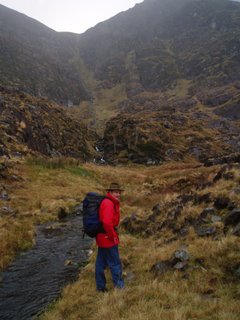 half we reached the cold blustery ridge next to a scree slope ascending toward the rest of the reeks, where we could see two other backpackers hiking up into the clouds. We made a hasty retreat in the unbelievably strong wind, and after making our way down the gorge, we finally stopped at some large rocks overlooking a small lake for a well-deserved beer break. While we were there, the lady of the lake emerged from the watery depths and gave
half we reached the cold blustery ridge next to a scree slope ascending toward the rest of the reeks, where we could see two other backpackers hiking up into the clouds. We made a hasty retreat in the unbelievably strong wind, and after making our way down the gorge, we finally stopped at some large rocks overlooking a small lake for a well-deserved beer break. While we were there, the lady of the lake emerged from the watery depths and gave
January 2
It seems to be sunny in the mornings here until around noon, then clouds come along and it becomes drizzly for the rest of the day, which isn’t too good for Walker and I since we’re such late starters in the mornings. We were the last ones leaving the hostel today, but still allowed ourselves the pleasure of a quick toss of the Frisbee in the parking lot outside the hostel. Heading straight for the
We’re still not sure if this is true or not; we didn’t come across that many. It would have helped if we had a bit more information on where they can be found;
Stopped at the town of
Killarney was our last new destination. We drove the shortest route back to
The 100 Mile Pizza
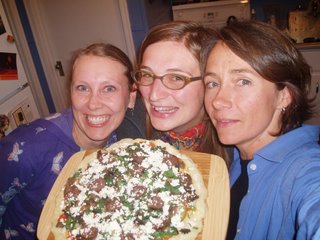 The folks from the Million Pizza Project put forth the following challenge:
The folks from the Million Pizza Project put forth the following challenge:1. make your own pizza (bonus points for making them with organic ingredients, super bonus if you grow your own sourdough culture for yeast)
2. pizza should have interesting, unusual ingredients, e.g. Richard Blume '06 found a pizza with Kangaroo on it in Australia
3. pizza is made with LOCAL ingredients - e.g. http://100milediet. org/ AND the topics of DIALOGUE during the making and eating are noted. Food and relaxed conversation are a great way to let minds explore tricky topics in a nice way.
To address this challenge, Joanna and I managed to find all-local toppings for this pizza experiment. The ONLY non-local ingredients were flour, baking powder, and vegetable oil.
So, here is the list of our local yukon ingredients:
tomatos
tomatillos
wild morel mushrooms
chard
goat feta
moose bratwurst
chives & herbs
potato (in the crust only)
These came from farmer's markets, Joanna's backyard, Heather's backyard, or the forest (thanks to Lawrence and Jake for the moose!). Annie joined us as a dinner guest and finished everything on her plate. We didn't discuss tricky subjects in the kitchen, but did have fun with this!
Introducing Chris
Saturday, November 25, 2006
Yukon Pond Hockey Tournament
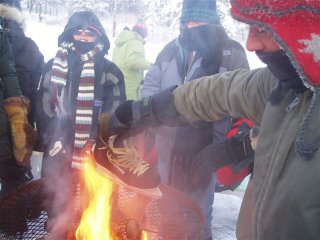 second year in a row for Whitehorse's Northern Pond Hockey Tournament on Chadburn Lake. My key-chain thermometer didn't go low enough though - only to -30 degrees. It was at least -35 in these photos, taken
second year in a row for Whitehorse's Northern Pond Hockey Tournament on Chadburn Lake. My key-chain thermometer didn't go low enough though - only to -30 degrees. It was at least -35 in these photos, taken 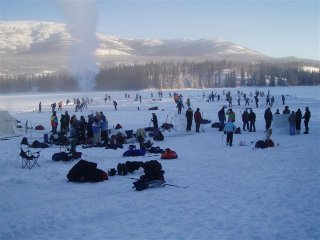 today.
today.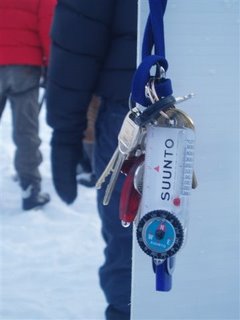
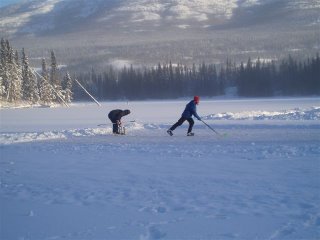
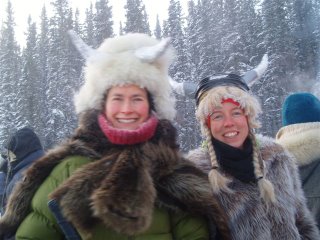
Sailing in the Cyclades! June 2006
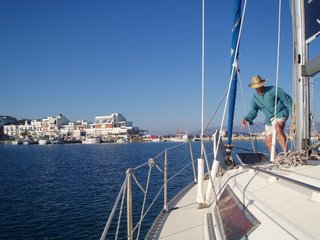
On completing the MSLS programme in Karlskrona, Sweden, a bunch of us went on a well-deserved sailing holiday in Greece. From June 8th to 22nd, Chris and I sailed from Athens around the Cyclades and back. We were happily joined by classmates Scotty, Ingrid, and Geneva on the first week, then Mel, Gunter, and Renee on the second week. We visited these islands: Aigina, Kithnos, Serifnos, Melos, Folegandros, Ios, Santorini, Delos, Paros, Tinos, and Kea. The following is the story of our absolutely fabulous trip!
On June 5 Chris and I got the bus to leave Karlskrona forever. We had a year’s worth of possessions with us after mailing a few books away, and trying unsuccessfully to sell Chris’ guitar back to the music store. He’s just as happy keeping it since it might come in handy on the sailboat. Goodbye Karlskrona!
We stayed the night in Copenhagen at The Saga Hotel which borders the red light district, and the owner agreed to store my big bags for free.....otherwise I would have paid $100 each way on the plane, or a similar amount for storage at the airport. Gotta love these family-run businesses!
The plan, after arriving in Greece, was to spend a couple of days in the town of Delphi before boarding the boat with the rest of the crew. In warm and sunny Athens, we got a car rental and drove out of town, taking an older, less busy highway to
The landscape was so dry-looking. We got lost along the way, asked a young woman in a “Kantina” for directions and thought we should at least buy a beer and souvlaki and sit for a while with the locals. Mmmm….beer and souvlaki in a rusty old cantina, under a raggedy old tent looking out to the dusty dry landscape and olive trees, sitting with a couple of old guys at the next table. They didn’t speak English like the cantina gal, but they took over the
responsibility of giving us directions with authority.
In 
Meditarranean with the little towns, like Galaxidi, twinkling below. We had a great meal with local greeks at a little place on the sidewalk: moussakas and roasted lamb (or mutton, really), greek salad and rose wine made locally. Stray cats are commonplace in
It’s quiet here in the mornings compared to the farm at Skarva that I got so used to over the previous few months. There are hardly any birds singing – at least no nightingales. Only a rooster in one of the houses surrounding the hotel crowed.
Got a late start for the Delphi museum and there were crowds of tourists, but it worked out OK because we could eavesdrop on the tourguides for a running explanation in English of everything. English guides were in the minority, and we were happy that we weren’t surrounded by Americans.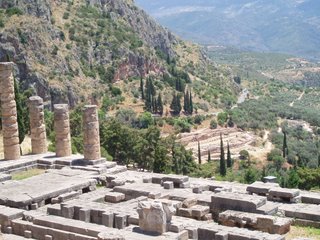
Many of the friezes on display were very badly damaged, either by earthquakes, but more often vandalism by overzealous Christians through history. The displays showed a good evolution of the art from 6th century BC to 4th century BC.
We went outside to see the original site of the town of
There were some tourists with extremely bad sunburns and it was a scorcher of a day. I went up to one and offered my own sun-lotion because she looked so bad and scorched and wasn’t even covering up, but she just ignored me.
The hike we decided on wasn’t exactly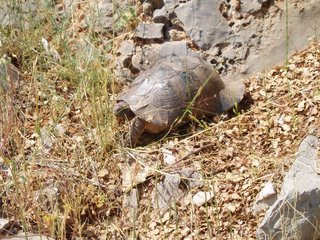
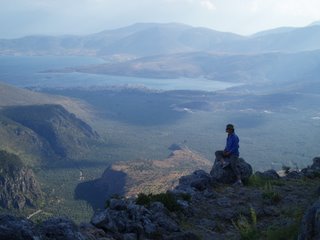 Further on at a spring cistern, we filled up our bottles. It was so hot and dry, the water was cold and sooooo good. We had a picnic of olives, bread, feta, and sausage, plus the ever-present beer. Continuing on, we came across a shepherds hut, fairly large, which looked more like a temple really, all mason work with a cross on top. There was a dog there – a large malamute-looking guy that need his undercoat to be brushed out (maybe I was just missing Buddy at the time). Unfortunately here you feel you need to carry a stick around unfamiliar dogs. We almost stepped on a large green snake that slithered away very spectacularly from under Chris’ feet.
Further on at a spring cistern, we filled up our bottles. It was so hot and dry, the water was cold and sooooo good. We had a picnic of olives, bread, feta, and sausage, plus the ever-present beer. Continuing on, we came across a shepherds hut, fairly large, which looked more like a temple really, all mason work with a cross on top. There was a dog there – a large malamute-looking guy that need his undercoat to be brushed out (maybe I was just missing Buddy at the time). Unfortunately here you feel you need to carry a stick around unfamiliar dogs. We almost stepped on a large green snake that slithered away very spectacularly from under Chris’ feet.
Continuing up through dry grass, big purple bull thistle flowers, and tons of other prickly plants, we came across a coniferous forest of large trees, some of which had fallen and become deadwood. It kinda looked like a healthy mature forest. Lots of big colourful scarab beetles flying around too.
We never reached the ruins that were supposed to be there. It was 5:30 and time to go back because Chris really wanted to catch the sunset from our balcony and sip on local rose wine (I’m soaking all this up). We ate at the same great place that night, feeding our leftovers to the same feral cats under the table.  Meow.
Meow.
Time to go sailing. We sped back into
The wind was coming strongly from the west and we got the sails underway as soon as we cleared the harbour. We didn’t turn the engine on again until the wind had died quite a bit from the “5” (on a scale from 1 to 12 called the “Beaufort scale”) that we had started with.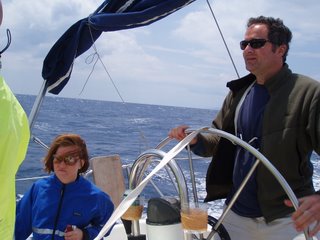
That night we moored on the island of “Aigina” at the town, Perdika. There were many Tavernas on shore, all filled with Greeks and tourists, looking down at us in the fading light, as we tried many times to fit ourselves into various spots, hitting the bottom once, as it was quite shallow. We eventually settled in, and went ashore for Saganaki, squid, mousaka, greek salad, lots of olives, and spanakopita, with 2 carafes of white wine. The stray cats let us scratch their heads, but we had no extra food for them, though they did get a feast from the other tables.
Overnight, the wind picked up and changed direction. The anchor unfortunately didn’t hold as expected, and we woke at 4 am to the sound of the fibreglass bow scraping on the cement pier we were tied to. No damage however and Chris and Scott got us secured again, and slept in late after.
The next day we had a long way to go from Aigina to the next overnight stay on the
Apparently one of these islands is inhabited by female vampires. We avoided these by paddling in the dingy in the other direction to a sandy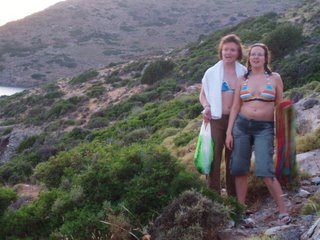 looking beach. We hiked up the slope on a goat path where we had seen the goaties travelling presumably to avoid the vampires at night. We found the rumoured hotsprings and had a bathe while Scotty was back at the boat cooking dinner. Other huge boats/yachts with staff in uniforms on board were anchored nearby.
looking beach. We hiked up the slope on a goat path where we had seen the goaties travelling presumably to avoid the vampires at night. We found the rumoured hotsprings and had a bathe while Scotty was back at the boat cooking dinner. Other huge boats/yachts with staff in uniforms on board were anchored nearby.
Before we left Kithnos the next day, we went for a little hike on the place where the vampires were supposed to be, but didn’t see any. Just a locked church and a greek man walking his donkey and two dogs. The island is dry, and even the thistles were having problems. I can’t imagine what all the goats eat, but ther droppings are everywhere.
Trying to disembark later, the sail was not rolled properly and we spent about an hour in a quiet bay trying to fix it. This involved Chirs sitting in a harness dangling from half way up the mast from a thin rope. A wooden spoon was the tool that finally got the mast unstuck. That day took us to the
Serifnos, on a Saturday night under a full moon, was in a partying mood. The entire beach is home to several Tavernas and they became quite full after 9. We had another round of cheap local rose, greek salads, souvlaki, and lamb chops, pureed fava beans for Ingrid the vegetarian, and very thick and garlicky tzatziki sauce. We didn’t stick around in town that long, except Scotty and Chris delivered us back to the boat in the dingy at around 11, and the two of them went back into watch the soccer game. Us gals held back on the boat to drink vodka.
The island overall is quite touristy, abut 1300 people live here, and there are a lot of jewellery shops and other tipico. We found the food good, and slightly more pricey than other places we’d been. Thre are a lot of boats moored here and big ones, some owned by greeks. There is a lot of money here.
There were no cats to feed the fat from my lamb chops to.
Our next stay was on the 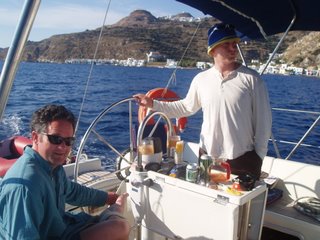 nights. It’s a larger town, at almost 5000, situated in the bay where a large crater was formed 1000’s of years ago after a volcano blew. Quite touristy, the place was really shaking late for a Sunday night, and often by greeks. Chris and I discovered a church where a celebration was going on. We had a good spot above the church courtyard which, when we checked back later, had filled up quite a bit with greeks. The band played with a bouzuki, and a fiddle played horizontal on the knee, with singing, to which a circle of dancers, mostly women, danced in a circle, back and forth in either direction. The dance resembled one we learned from Onur (from
nights. It’s a larger town, at almost 5000, situated in the bay where a large crater was formed 1000’s of years ago after a volcano blew. Quite touristy, the place was really shaking late for a Sunday night, and often by greeks. Chris and I discovered a church where a celebration was going on. We had a good spot above the church courtyard which, when we checked back later, had filled up quite a bit with greeks. The band played with a bouzuki, and a fiddle played horizontal on the knee, with singing, to which a circle of dancers, mostly women, danced in a circle, back and forth in either direction. The dance resembled one we learned from Onur (from
All the next day we zoomed around on rented scooters up to some Mycean settlements/ruins where a forgotten (?) archaeological dig had been underway, and the broken ancient pottery was everywhere on the ground, along with obsidian flakes. There were caves along our journey 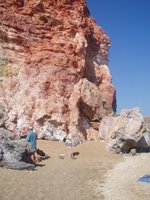 as well, active mine sites further inland, and we spent a lot of time on a beach under some magnificent cliffs of red and yellow, and very hot hot hot springs here. Lots of caves and holes in the volcanic rock in the water too, attracting an octopus that we saw slurping back into his hole.
as well, active mine sites further inland, and we spent a lot of time on a beach under some magnificent cliffs of red and yellow, and very hot hot hot springs here. Lots of caves and holes in the volcanic rock in the water too, attracting an octopus that we saw slurping back into his hole.
Scotty snuck back up the stairs into the tabepna to watch
We left
On June 14, we left Folegandros for Ios. The trip was windy and we had to do some tacking for the first time on the trip. At Port Ios we got the last mooring closest to town which turned out to be right IN town, with stores and tabepnas only 10 meters from our boat.
Next day we boarded a “Hellenic Seaways” fast ferry for €16 each to Santorini, arriving 40 minutes later. Renee was supposed to be at port, but we missed her and the many buses heading to town. It turned out to be a good thing, since it got Chris and Ingrid on the car rental hunt, which turned out to be a lot more useful over the next 24 hours than taking a bus.
We later met up with Mel and Gunter at the centre square and the 7 of us had lunch at a cozy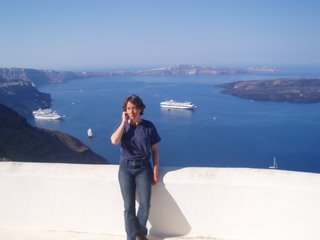 little spot with excellent yummy mousakas with nutmeg. We also tried sardines, white house wine, eggplant, and of course, greek salad. It was a scorching hot day as we walked through the treacherous traffic in the narrow streets with no side walks, to Gunter’s family’s summer house. The house was perfectly situated on an outcropping above the caldera, 18 kms acros, from which we could see ferries and boats coming and going far below. The caldera has steep cliffs that
little spot with excellent yummy mousakas with nutmeg. We also tried sardines, white house wine, eggplant, and of course, greek salad. It was a scorching hot day as we walked through the treacherous traffic in the narrow streets with no side walks, to Gunter’s family’s summer house. The house was perfectly situated on an outcropping above the caldera, 18 kms acros, from which we could see ferries and boats coming and going far below. The caldera has steep cliffs that
We did try doing some site-seeing that afternoon in Santorini, but the site of Acrotiri was closed since last year; someone had died in an accident involving collapsing ruins. The site of ancient 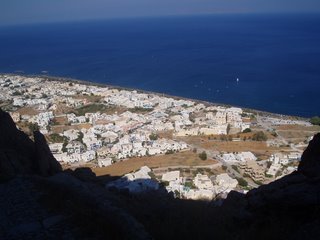 natural springs. The
natural springs. The
Back at the house that night we had a grand meal of grilled sausage, chicken and pork, veggies, greek salad and beans with local rose wine. Stray dogs and cats found their way to the patio, but the cats were the only ones to get any scraps since the dogs, a couple of greyhound puppies, were too shy and skittish. Chris said he threw them some bread once and they just ran away, even though they are obviously starving with their ribs showing.
Next morning we said goodbye to Scott, who was off to
That afternoon, Gunter, Mel, Chris and I made it back to Ios on the fast ferry from Santorini, and met up with Renee who had found our sailboat without any trouble, thankfully. We stocked up at our favourite store and headed for the 
The wind was now not in our favour and we needed to do some tacking, and anticipate a lot more of this in the coming days as our new direction travel was in the opposite direction. A dophin accompanied us part of the way!
We got into Pisa Lavadhi on Paros in the evening, and moored at the large breakwater there. This is a small town on a fairly big island. This was Chris’ choice as he had worked here 20 years earlier as a charter captain. He had many stories …We went to one of his old hang-outs, Fusilanis, above which his girlfriend used to live 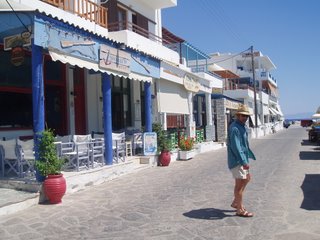 in an apartment. The owner, George, was there and claimed he remembered Chris. Someone from a nearby table came over and introduced himself as someone who had gone on one of Chris’ charters 20 years ago.
in an apartment. The owner, George, was there and claimed he remembered Chris. Someone from a nearby table came over and introduced himself as someone who had gone on one of Chris’ charters 20 years ago.
The next day saw favourable winds that we wanted to take advantage of, and we regretted not spending more time exploring the island. Chris and I did get to do some jogging and swimming while Mel, Renee, and Gunter had some fish stew with some Egyptian fishermen in a nearby boat. These fishermen did not speak English but were very hospitable and made each of them necklaces and bracelets out of fishing net string.
We got a late start and that night was spent again on Paros, this time over at the town of Naousa, on the north end. It was a great little bay, and we all had a morning swim then cruised over to
North East of our position was
While at Naousa earlier that day, Mel had bought a large batch of fish from some fishermen (for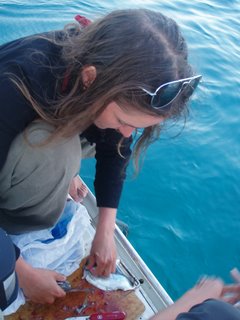 10 euros and a bottle of coke), and her and Renee cleaned them for dinner. They were very small, no longer than 6” in length, and a variety of species. The only kind I recognized was mackerel. Mel ate a raw fish eye!
10 euros and a bottle of coke), and her and Renee cleaned them for dinner. They were very small, no longer than 6” in length, and a variety of species. The only kind I recognized was mackerel. Mel ate a raw fish eye!
Since Delos, an ancient ruins site that was second in importance in antiquity only to
We saw another sea turtle just below the surface and narrowly missed hitting it! She must have been 3’ in diameter. How do they survive the boat traffic here?
Mooring at
Mooring in
The street was very busy with traffic and was quite noisy, but the streets leading further up the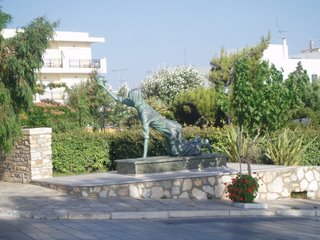 hill looked quiet and inviting. They were narrow and packed with shops, ascending to a large church, probably a nunnery. At the foot of this on the street, was a young woman on her hands and knees, crawling on the ground toward the church. Chris figured she was cleansing herself, doing some kind of penance for her sins. We tried not to stare. Later we came across a statue of a woman doing exactly this. There is also a carpet leading all the way up the side of the street, specially placed for this purpose?
hill looked quiet and inviting. They were narrow and packed with shops, ascending to a large church, probably a nunnery. At the foot of this on the street, was a young woman on her hands and knees, crawling on the ground toward the church. Chris figured she was cleansing herself, doing some kind of penance for her sins. We tried not to stare. Later we came across a statue of a woman doing exactly this. There is also a carpet leading all the way up the side of the street, specially placed for this purpose?
The next day we attempted an early start from
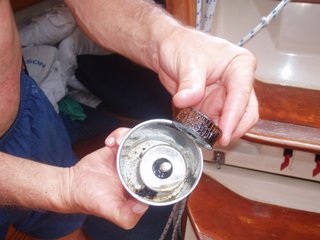 Chris was familiar enough with the engine thankfully to figure out that the fuel filter was plugged with the algae growth, which started in the fuel tank. In warmer climates, you need to use additives in the fuel to deal with algae growth, which obviously had not been done for a long time. He just took out the primary filter, and let the secondary filter do the job. Dimitri, the boat’s owner, was embarrassed later when we told him about it and didn’t charge us to re-fill the tank. It could have been a lot more embarrassing for him if we had to call the coast guard!
Chris was familiar enough with the engine thankfully to figure out that the fuel filter was plugged with the algae growth, which started in the fuel tank. In warmer climates, you need to use additives in the fuel to deal with algae growth, which obviously had not been done for a long time. He just took out the primary filter, and let the secondary filter do the job. Dimitri, the boat’s owner, was embarrassed later when we told him about it and didn’t charge us to re-fill the tank. It could have been a lot more embarrassing for him if we had to call the coast guard!
That night at the 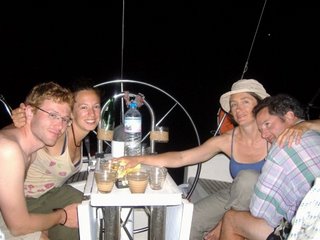
The way to Korissia led us through a neighbourhood of expensive looking houses, large gates, security systems, lots of flower gardens and new housing construction sites. The town is very busy at dusk, the butcher was still working, the cafes full of people drinking their coffees, soft drinks and beer, large tables of greek men eating their dinners. We had souvlaki, greek coffee and beer as the greeks cheered for
The greek boys are beautiful here!
The cats here were getting into the trash for their evening meal as we walked back, also lots of grasshoppers flying around the streetlights. They’re huge and it was fun watching one cat leaping after them.
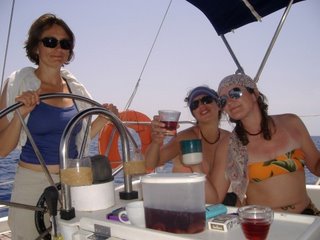 The waters were calm the next day, but we didn’t have to go far. We originally headed for Aigina, just of the mainland west of
The waters were calm the next day, but we didn’t have to go far. We originally headed for Aigina, just of the mainland west of 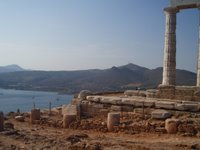
We were still in plain view of the temple from our anchored spot in the bay. Later on that night, someone lit a campfire in one of the caves on the beach, and it looked so primitive and beautiful with the cave walls lit up from the warm glow of the fire. The temple was also lit up with artificial lights high on the cliff in the distance, under the starry sky.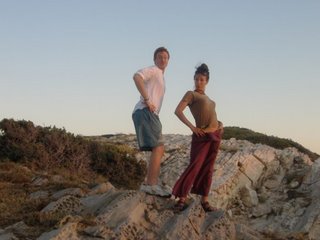
When we hiked up to the temple the next day, it was sunny and really hot. The temple has been rebuilt since its columns and blocks of marble were dismantled and scattered by Persians and other destructive forces long ago. Lord Byron was supposed to have carved his initials in one of the pieces here. Lots of carved grafitti covered the temple pieces.
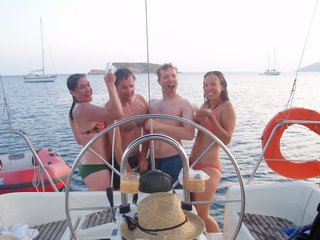 The taverna down on the beach was so inviting in the heat. We finally retreated there on the path through wild oregano with purple flowers and honeybees, for a frappe, beer, pepsi, a plate of olives, and bread. Several toasts to our trip and ourselves were made, and we all felt very happy about everything!
The taverna down on the beach was so inviting in the heat. We finally retreated there on the path through wild oregano with purple flowers and honeybees, for a frappe, beer, pepsi, a plate of olives, and bread. Several toasts to our trip and ourselves were made, and we all felt very happy about everything!
